Family : Pomacanthidae

Text © Giuseppe Mazza

English translation by Mario Beltramini
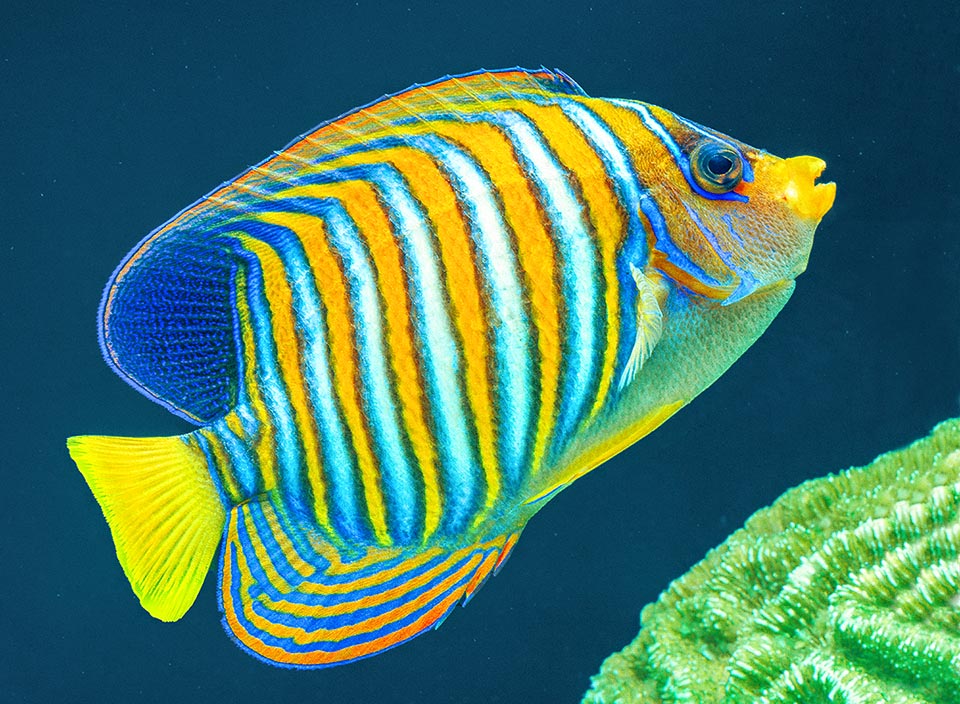
Present in the Indo-Pacific tropical waters with various orange shades, Pygoplites diacanthus is one of the finest angelfishes © Giuseppe Mazza
The Regal angelfish (Pygoplites diacanthus Boddaert, 1772), belongs to the class of the Actinopterygii, the ray-finned fishes, to the order of Perciformes and to the family of Pomacanthidae, which counts 8 genera and 91 species.
The etymology of the name “pygoplites” comes from the Greek “pyg” = rear and “hoplites” = hoplite, the name of the strongly armed soldiers of the Greek heavy infantry.
The name “diacanthus” comes always from the Greek “dia-” = by means of, and “akantha” = spine.
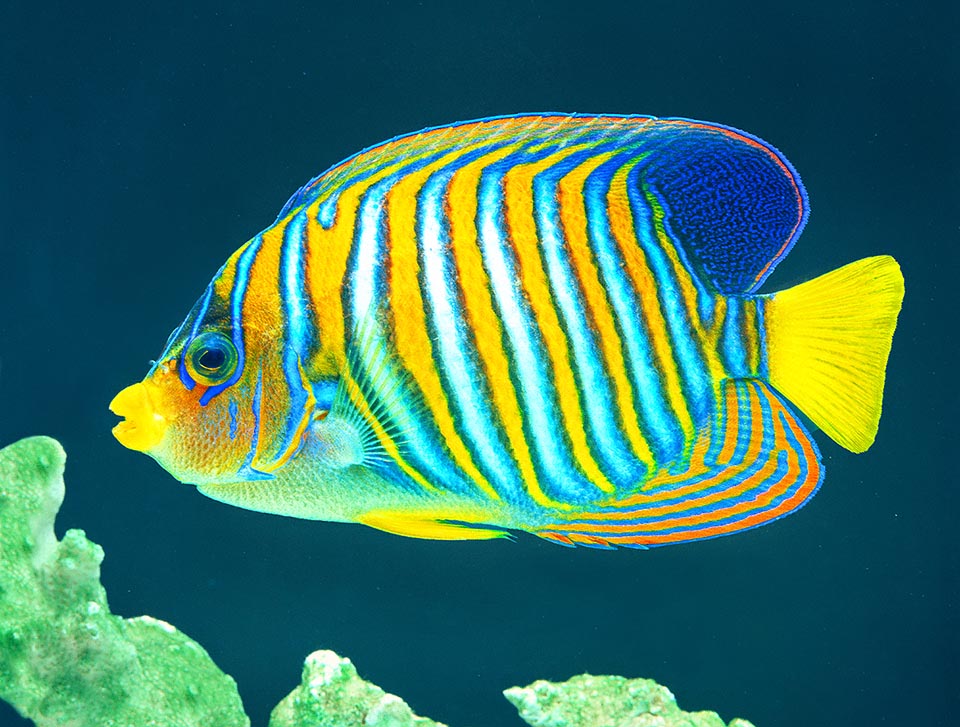
All would like to have it at home, and nurseries were born, but it’s almost impossible to feed and is very sensitive to oidium, the white dots disease © Giuseppe Mazza
It is matter, therefore, of a “well armed fish by means of a spine bent backwards” with reference to the spiny preoperculum typical of the family.
Zoogeography
It is present in the tropical waters of the Indo-Pacific. Indicatively, we find it from East Africa and Madagascar up to the Seychelles and the Red Sea, to the Maldives, Sri Lanka, in Thailand, Malaysia, Indonesia, New Guinea, Australia, Micronesia, Philippines, Taiwan and China up to the southern part of Japan with the Ryukyu and Ogasawara Islands.
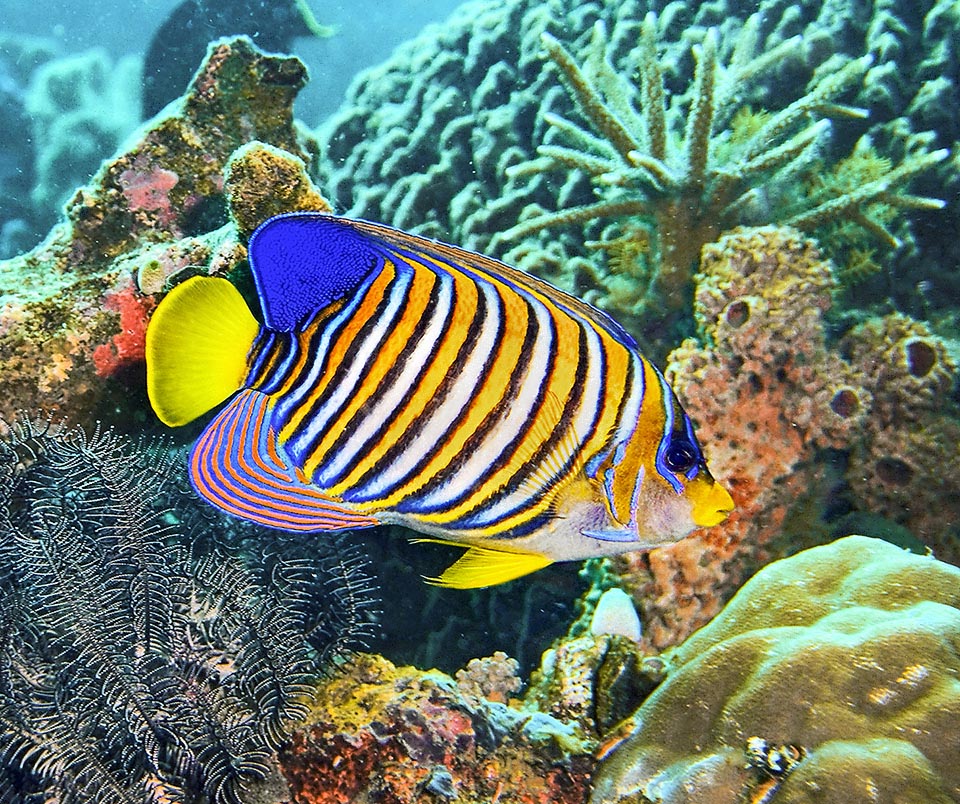
Can be 25 cm of length twirling among corals up to 50 m of depth, where the showy livery actually turns out to be very mimetic © Karine Marangon
South-eastwards, it reaches the New Caledonia, Vanuatu, the Fiji Islands, Tonga, Tahiti and Tuamotu.
Ecology-Habitat
It lives among the madrepores and the corals in shallow waters, usually not under the 50 m of depth. They love the corals of the genus Acropora which protect them upward with their spikes and welcome them under their flat structure rich of hiding places.
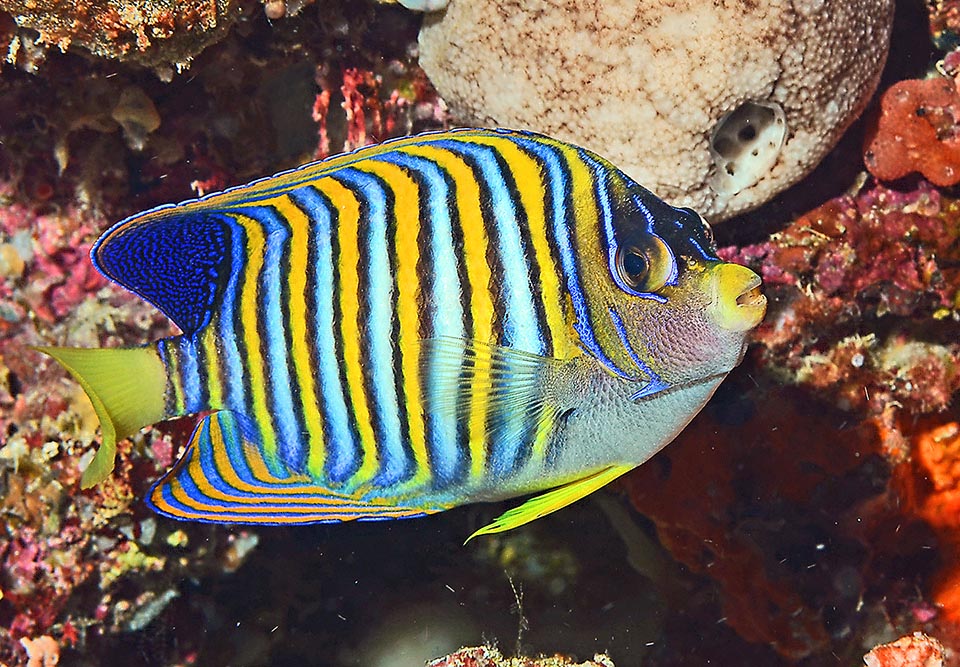
Flat and oval, it has a robust protruding bill for rummaging into the crevices, detaching fragments of encrusting algae and nibbling the leaves of the submerged prairies © Benoit Lallement
Morpho-physiology
It can reach the length of 25 cm. The body is flat, oval, with a sort of a robust and protruding beak for searching along the corals nibbling benthic invertebrates. The dorsal and the anal fins are wide and rounded.
The first counts 14 spiny rays and 17-18 soft; the second 3 spines and 17-19 unarmed rays. The pectoral fins have 16-17 soft rays and the ventral ones, spineless, are long and pointed. The caudal fin is more or less truncated.
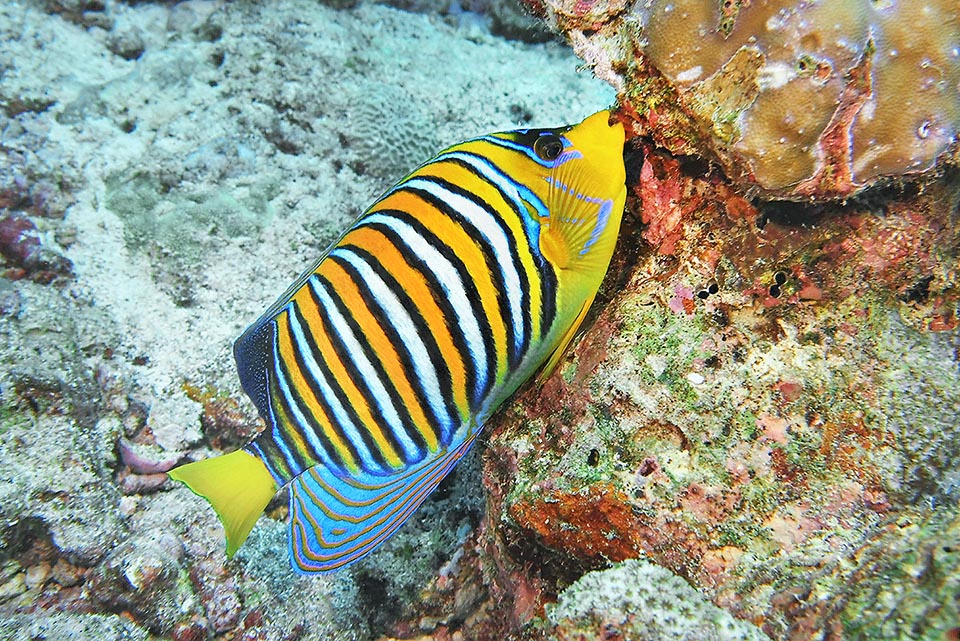
Here at work. In any case the main dish consists in sponges and ascidia, and for this when in captivity it dies of hunger © Karine Marangon
The livery is really dramatic. On the yellow-orange body stand out some vertical white stripes, slightly oblique, bordered of black and light blue, which get thinner and blue near to the eyes and proceed in the dorsal fin which ends with an intense blue zone. On the anal one, the inclination of the stripes changes, it is parallel to the border in an elegant alternation of blue and orange. The tail is yellow.
The juvenile livery is very different. At first glance, it might be mistaken with a Chaetodon, as some synonyms indicate, with a false enormous eye at the base of the dorsal fin.
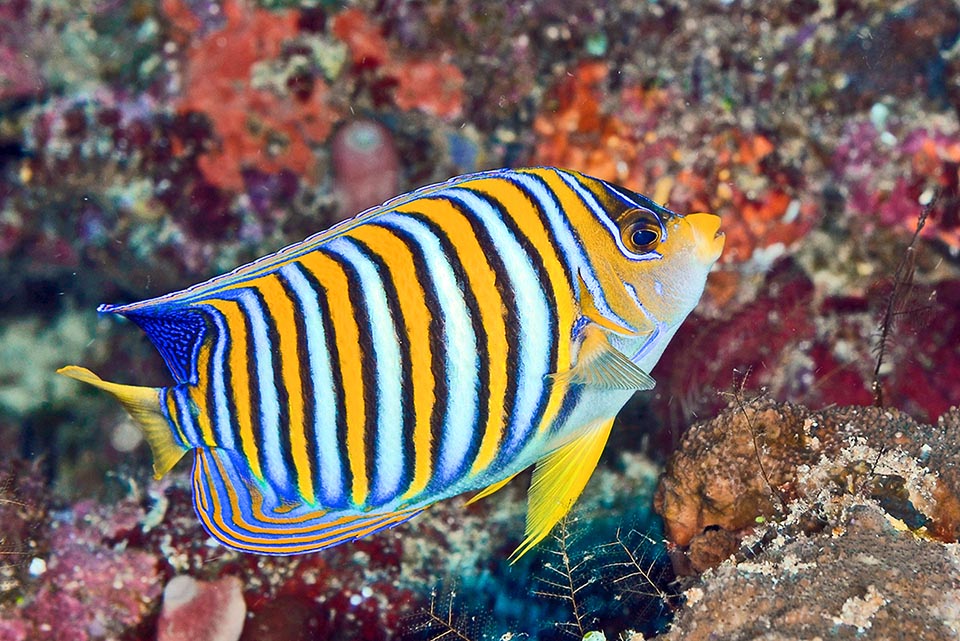
Pygoplites diacanthus lives mainly solitary, but also in couples and at times it is possible to meet it in small schools © Benoit Lallement
The white vertical bands which gradually appear stand on a yellow background in the populations of the Pacific Ocean and orange for those of the Indian Ocean.
Ethology-Reproductive Biology
Pygoplites diacanthus often lives solitary, but also in couples or in small schools nourishing chiefly of sponges and ascidia, integrated by fragments of encrusting and phanerogamous algae of the submerged prairies
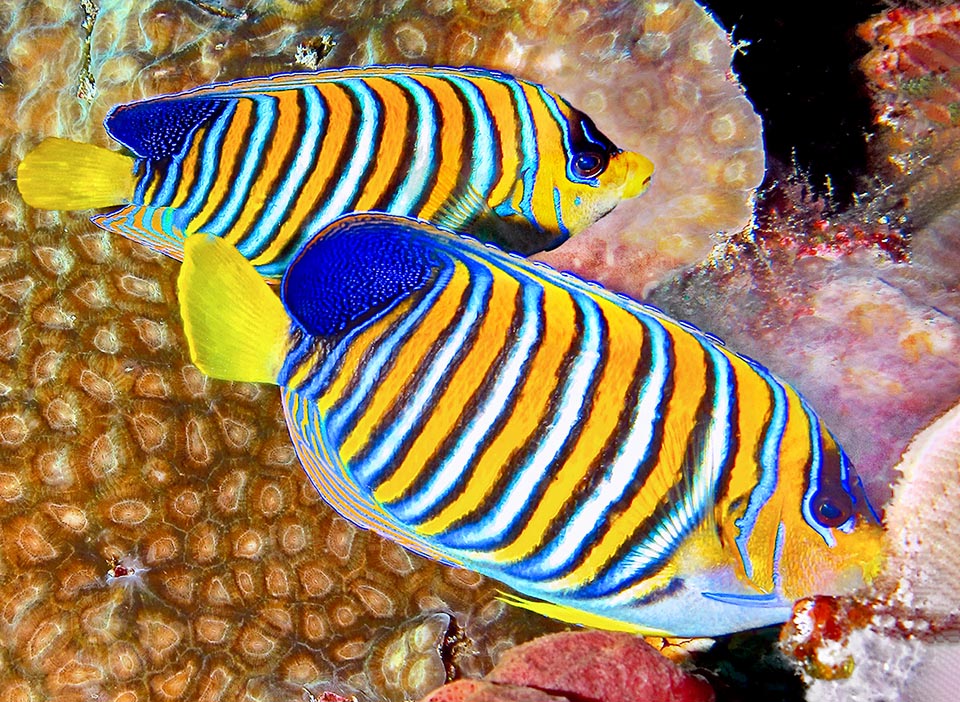
For reproduction the couples move up to the surface spirally with the male above that fecundates the eggs © Bernard Dupont
The egg laying takes place usually during the twilight or the night. The couples move up dancing spirally towards the surface with the male, above, fecundating them as soon as they are released.
The larvae are planktonic and the juveniles grow up hidden among the corals.
In nature the Regal angelfish can live even 10 years, but in captivity, due to its particular type of feeding, it miserably dies starving.
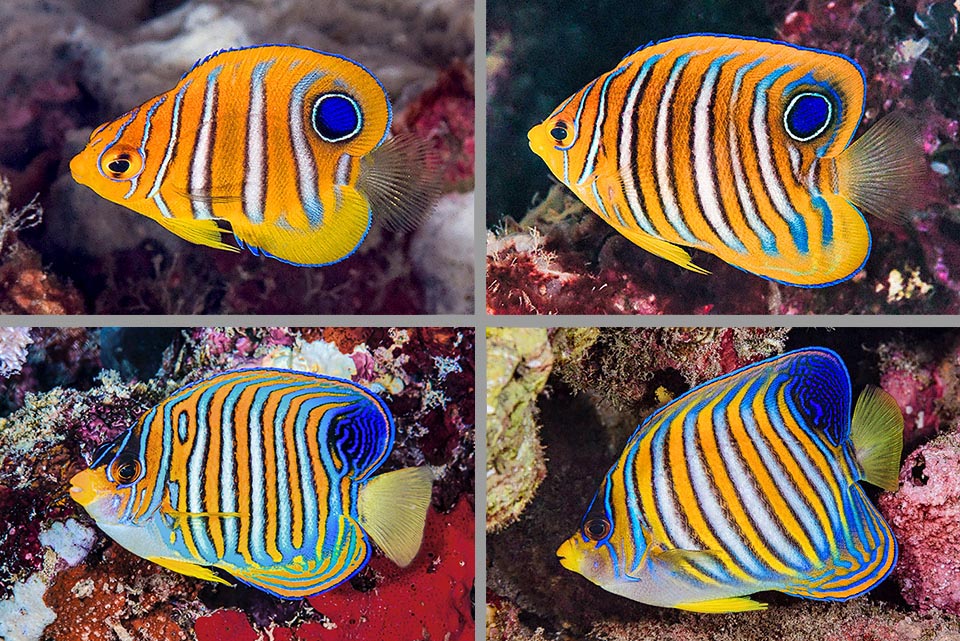
The growing juveniles are roundish with a fake eye towards the tail on the dorsal fin. Here the changes of the juvenile livery almost up to a subadult © François Libert
Driven by the strong market demand, they are born in the nurseries that propose, together with the fish, feeding surrogates, but the life expectancy within the domestic walls keep however very low because it is a species very sensitive to Oodinium ocellatum, a dinoflagellate protozoan present very often in the aquaria attacks the fins, the gills and the skin of the guest until the same falls into shreds.
This is the ill-famed “white spot disease” the fish merchants know and treat in advance until the time of the sale.
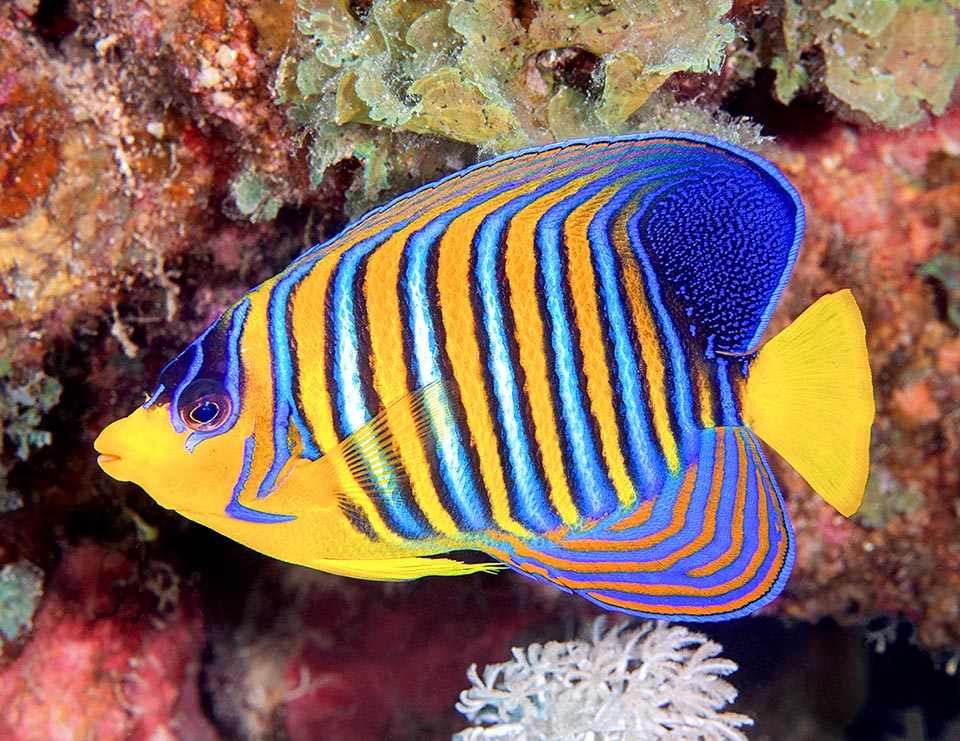
The adults are more elongated. The dorsal and the anal fins show big arabesques and the blue preopercular spine appears threatening all over its length © Rafi Amar
The resilience of Pygoplites diacanthus is low, with a minimum doubling time of the population of 4,5-14 years, but on the other hand the fishing vulnerability is low, marking only 21 on a scale of 100. In the Red List of the endangered species the Regal angelfish appears in the category “Least Concern”.
Synonyms
Chaetodon diacanthus Boddaert, 1772; Holacanthus diacanthus Boddaert, 1772.
→ For general information about FISH please click here.
→ For general information about BONY FISH please click here
→ For general information about CARTILAGINOUS FISH please click here.
→ To appreciate the BIODIVERSITY of BONY FISH please click here.
→ To appreciate the BIODIVERSITY of CARTILAGINOUS FISH please click here.
